
Irish Ladies Tresses, Spiranthes romanzoffiana
My notes from fantastic talk ‘Wild Orchids of Wales’ by Sue Parker, Publicity Officer at Hardy Orchid Society
Great talk by Sue Parker at Llechryd & District Gardening Club. She’s part of First Nature who publish a whole range of wildlife guides and books, and she’s Publicity Officer for the Hardy Orchid Society.
She has written a lovely looking book called Wild Orchids of Wales, I have added it to my reading list.
These are my rather random notes from the talk, in no particular order. Lots about where to see particular orchids in Wales.
- “Rye grass is a destroyer of wildlife and particularly of wild flowers”
- Orchids don’t survive if dug up and moved to a garden. Sit in Abercych totally stripped 😢
- Nature reserves - see website for full list
- 75 National Nature Reserves in Wales
- As many local Nature Reserves
100 Wildlife Trust sites
- RSPB sites
- Gallery of UK & Ireland wild orchids on website
- Gymnodenia cnopsea, Chalk Fragrant Orchid, limestone
- Rhinanthus major, Yellow Rattle, top orchid indicator
- Indicators alkaline soil: Chalk Milkwort, Bloody Cranesbill, Oregano, Spring Gentian
- Indicators acid moorland: Bog Asphodel, Common Butterwort, ?
- Anglesey, alkaline, sea shells
- Alan Waters country Park, The Warren, Anglesey Fens
- Dactylorhiza maculata, Heath Spotted Orchid, likes acid soil
- Minera Quarry, turned into nature reserve (turn the world into a nature reserve…)
- Vicarage Meadows, Small White Orchid, Brecknock Wildlife Trust
- Elan Valley East, Hammerbya palidosa, Bog Orchid
- Oxwich Bay in July, Anacamplis pyramidalis, Pyramidical Orchid, great numbers
- Kensig National Nature Reserve, nr Port Talbot, Liparis loeslii, Fen Orchid, pioneer orchid
- Dyfi National Nature Reserve, Borth (hybrid hotspot)
- Spiranthes romanzoffiana, Irish Ladies Tresses, extinct now in England, recorded for 1st time ever in Wales, July 2019. The talk of the orchid town!
- Doesn’t occur in Europe: Wales, Ireland & North America
- Orchid requires fungi to propagate because seed so small it carries no nutrients, needs symbiotic exchange with fungi
After the talk, I managed to talk with Sue’s partner Pat O’Reilly, author of Fascinated by Fungi. Short but very interesting chat about fungi. There’s a totally purple orchid in France that is only found by a certain species of Pine and Russula fungi. It doesn’t have any chlorophyll, and parasitises the relationship between the pine and the fungi. Fascinating.